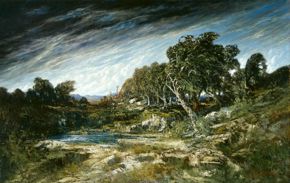In the Beginning November 3, 2011

Gustave Courbet, The Gust of Wind, c. 1865, oil on canvas, the Museum of Fine Arts, Houston, gift of Caroline Wiess Law.
In January of 2010, the MFAH Archives received a grant from the National Historical Publications and Records Commission to study and plan the implementation of a trustworthy electronic records archive over a two-year period. The objective of the grant is to extend the archival function of preserving the museum’s permanent records into the electronic realm, since, after all, that is how records are created these days. Two years seemed a luxurious amount of time back then, these days, not so much. Sitting down to write my first blog entry – adding, I might note, to the sixty terabytes of data already whirling on the museum’s more than thirty virtual servers - I began to reflect on what could possibly have driven me to tackle the problem of e-records preservation. Believe me, ever since the 1993 federal ruling in Armstrong v. Executive Office of the President, “better men” than I have been working on it. I know because, try as I might, I have only scratched the surface on the research and projects conducted by the U.S. National Archives and Records Administration, PeDALS, InterPARES, PLANETS and a handful of other notable endeavors.
I could give a host of professional reasons for initiating the project – that electronic versions, and not hardcopies, are the original records; that the historic record is at risk; that emerging solutions should be scalable to cultural institutions – but the personal truth is a fascination with the possibilities the virtual realm has to offer. As a layman, it will always seem a little like magic. The potential dawned on me about ten years ago when I discovered that academic researchers were testing blob recognition for, as one example, distinguishing urban scenes from seascapes. It was beyond my imagination that in less than a decade facial and landscape recognition would be available in the commercial market. My imagination jumped instead to moving images and the implication for cataloguing. If automated identification of still images was possible, could moving images be far behind (it’s not) and, if so, how relevant would the subject terms hurricanes, typhoons, cyclones, or les ouragans or be when ultimately a bitstream could “label” a storm’s particular forms and movement? What would stop that bitstream, I daydreamed further, from being applied to newspaper articles or library books? A “term” that breached the boundaries of nomenclatures and language. One day, but, in the meantime, there are those unarchived terabytes of data whirling on the servers like a typhoon of its own.





